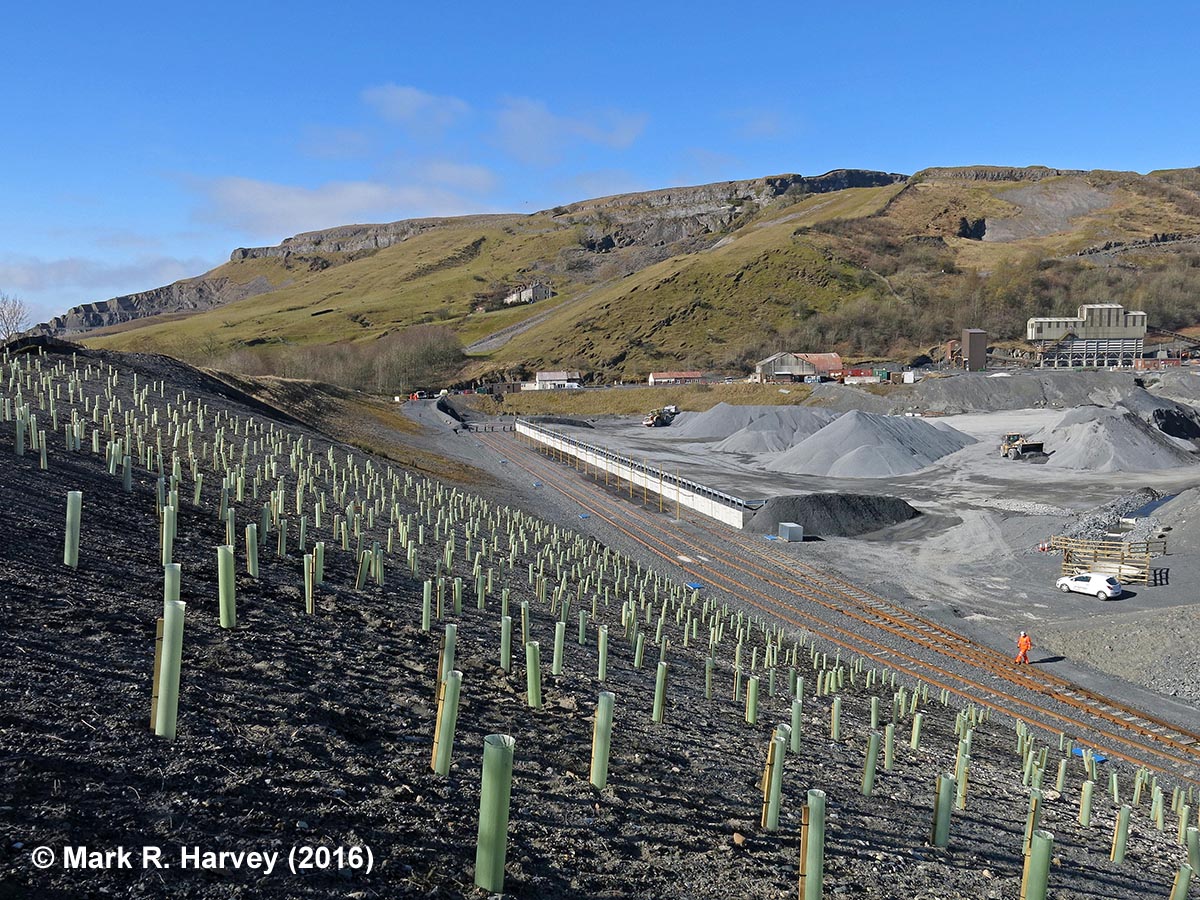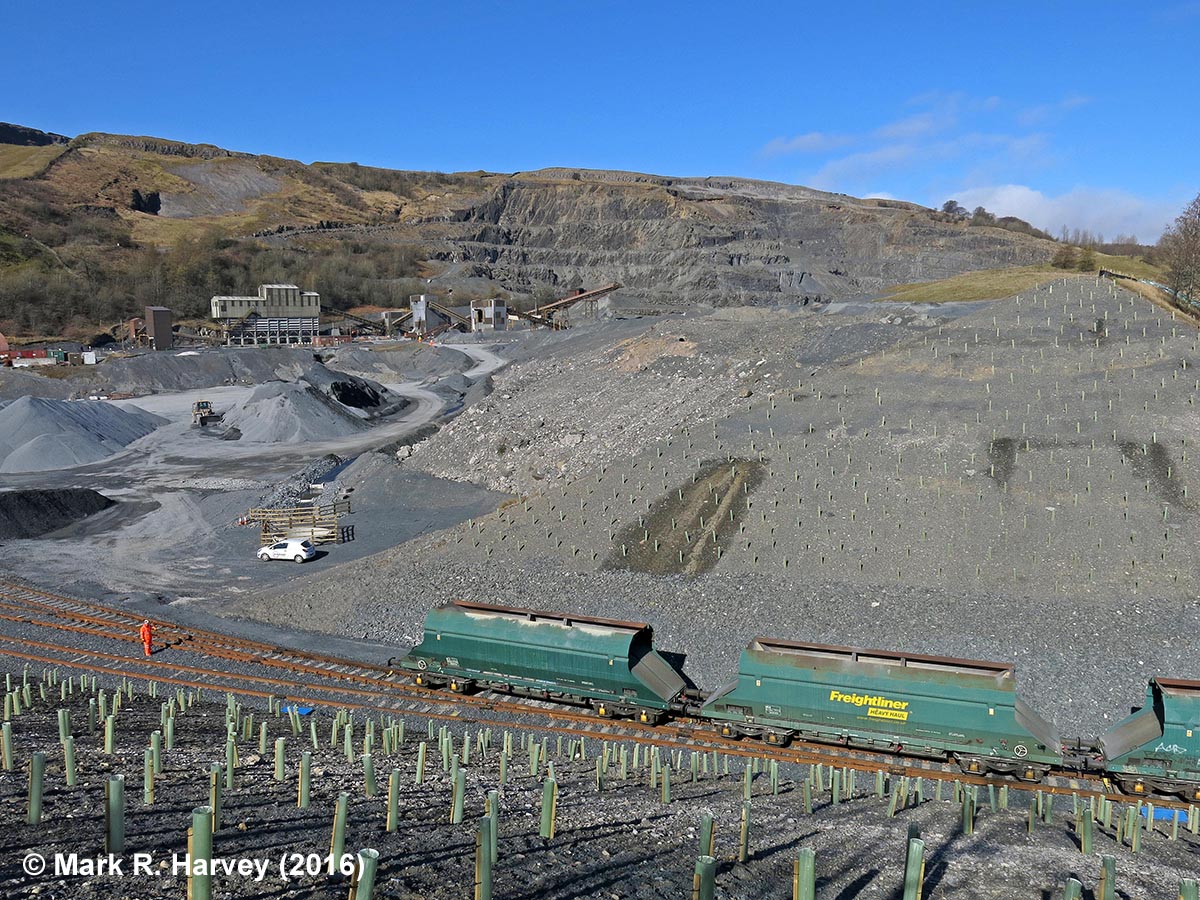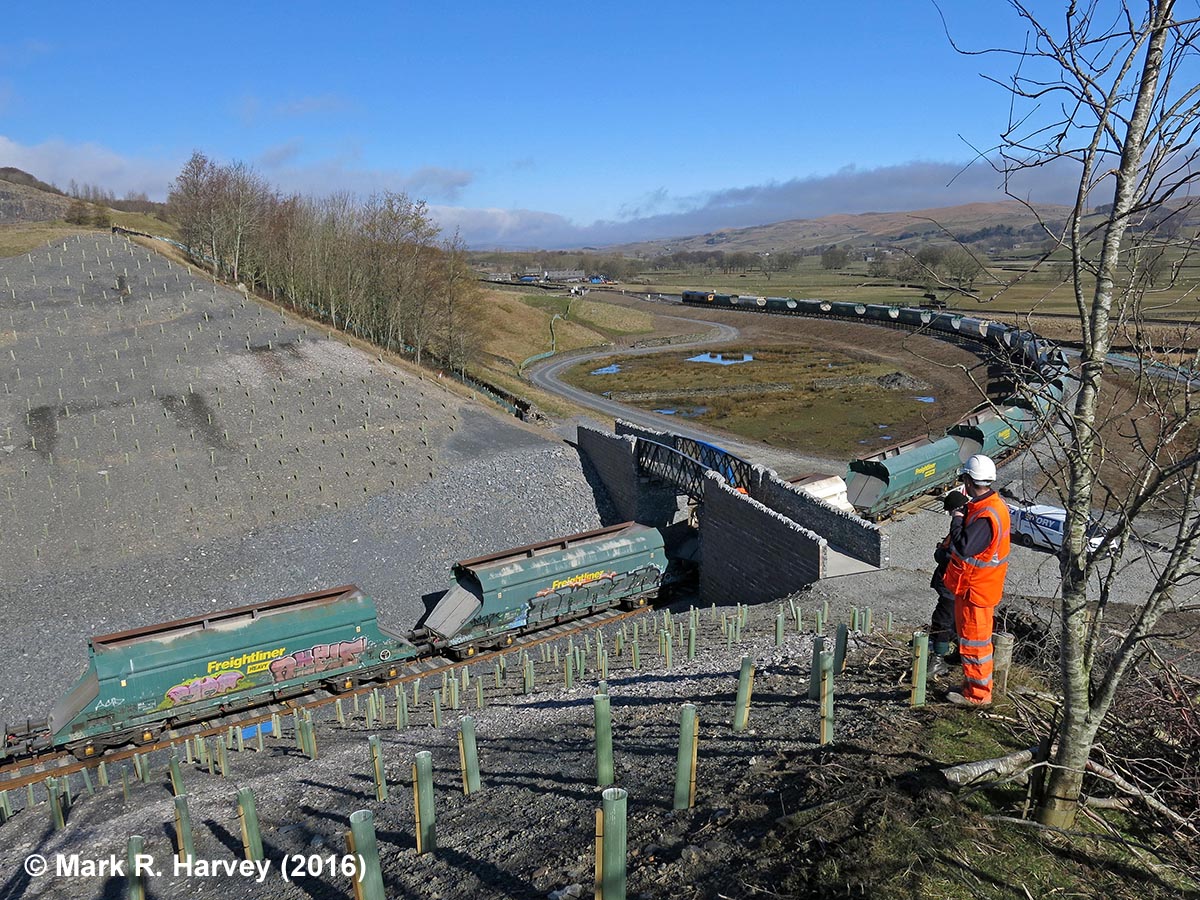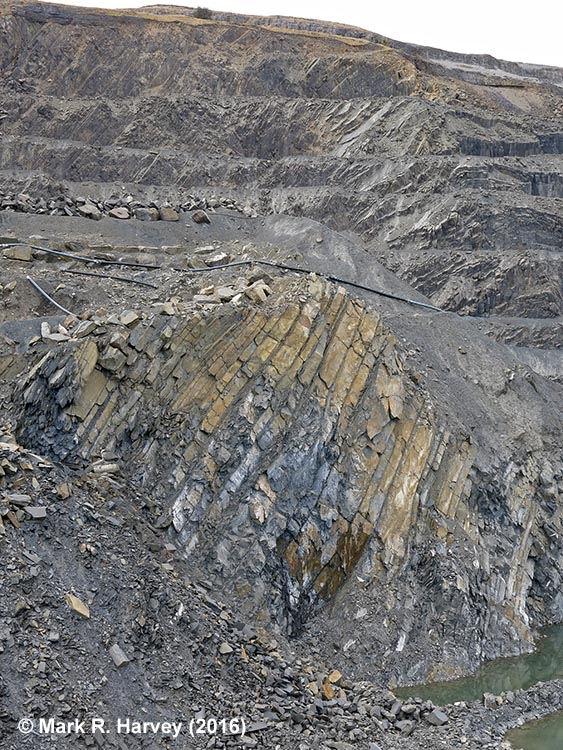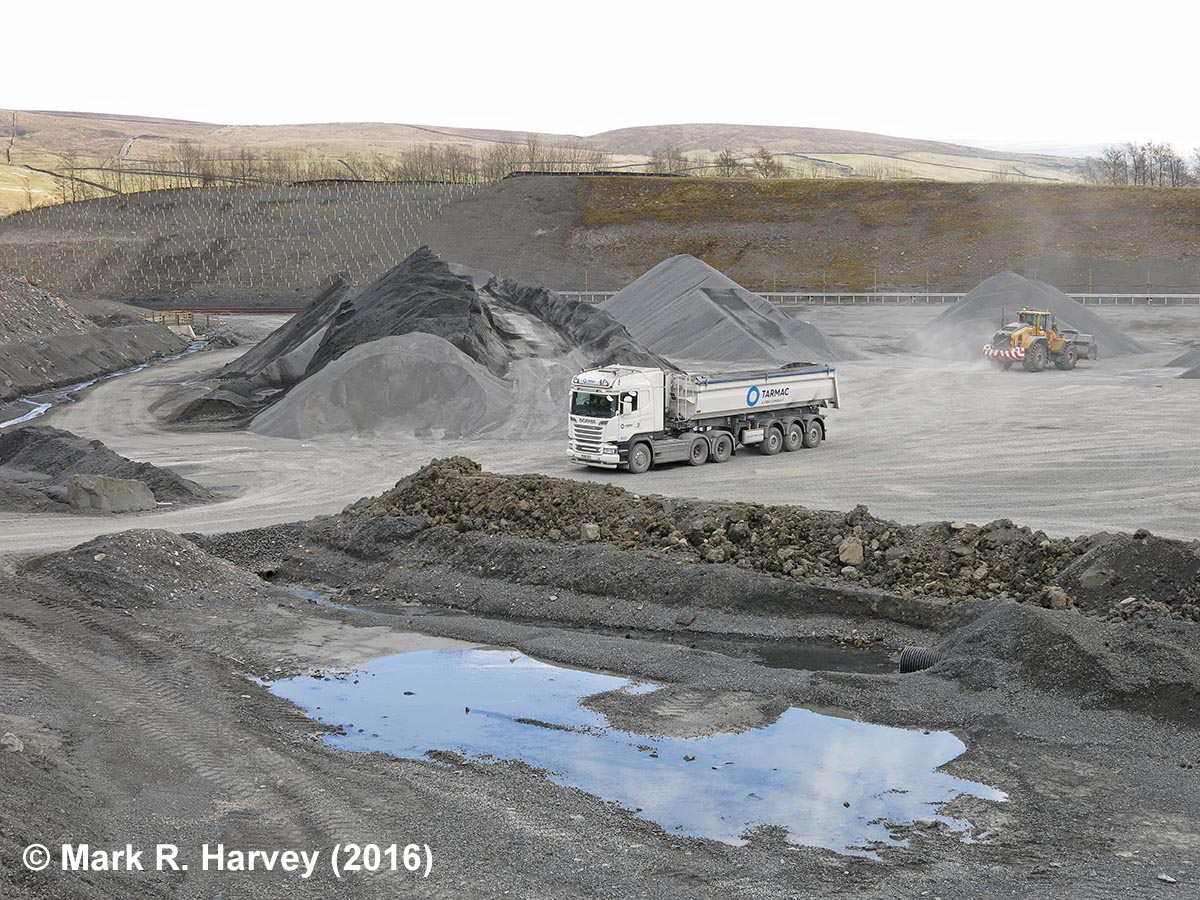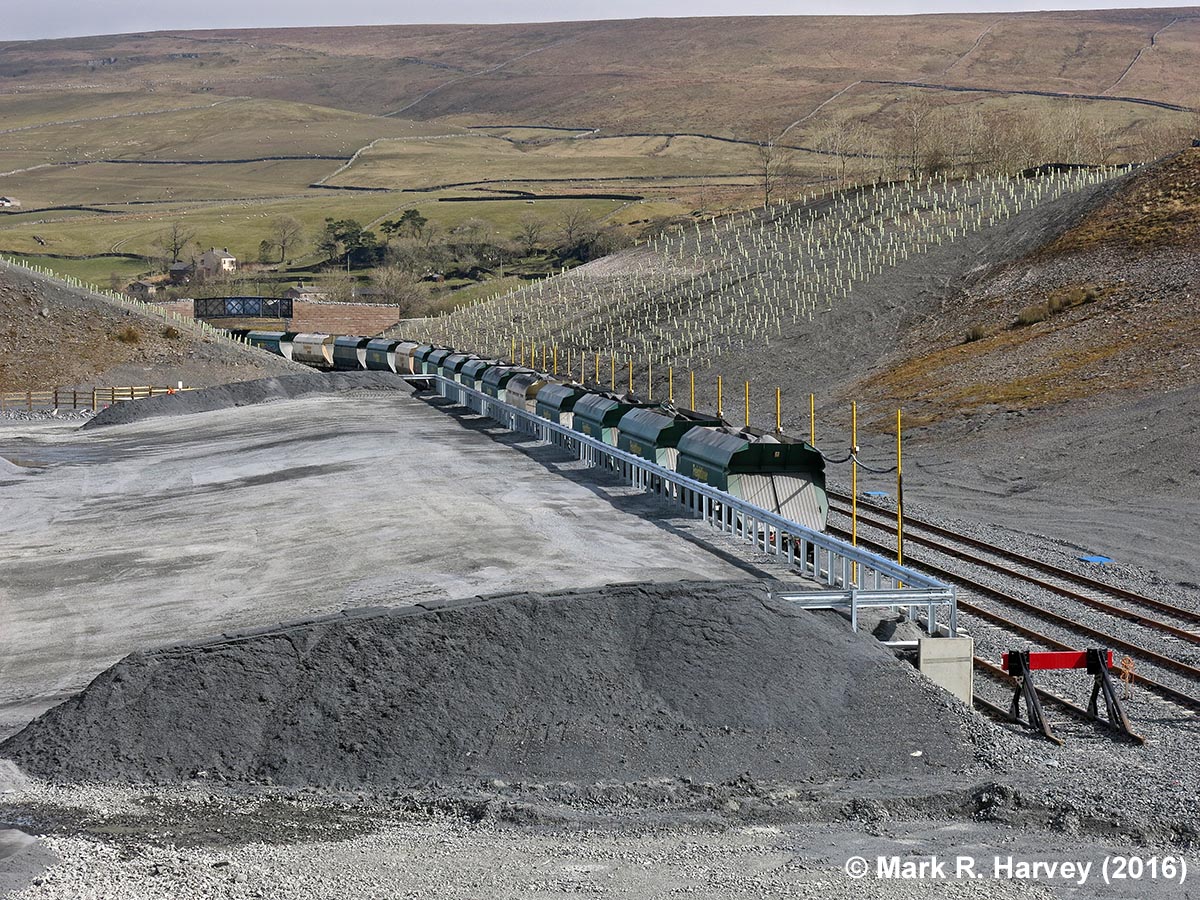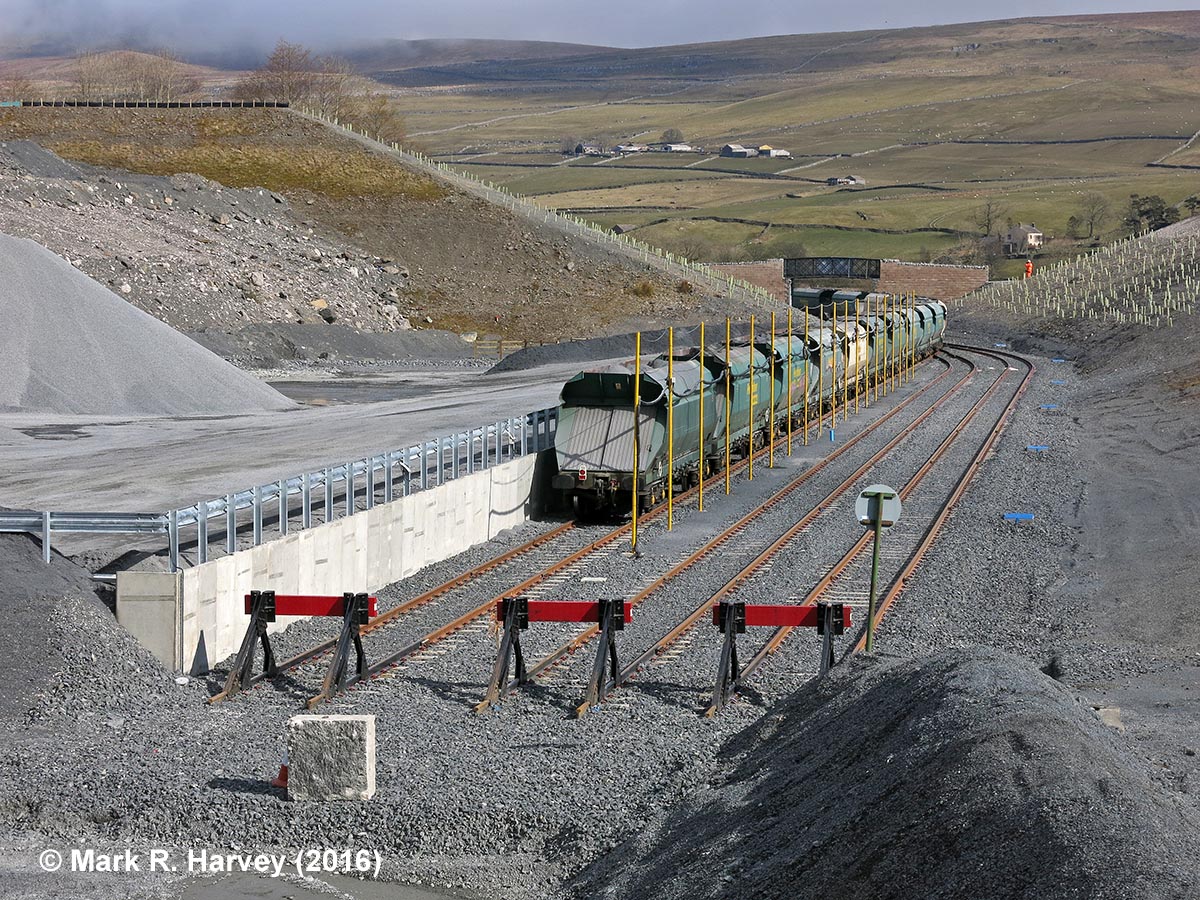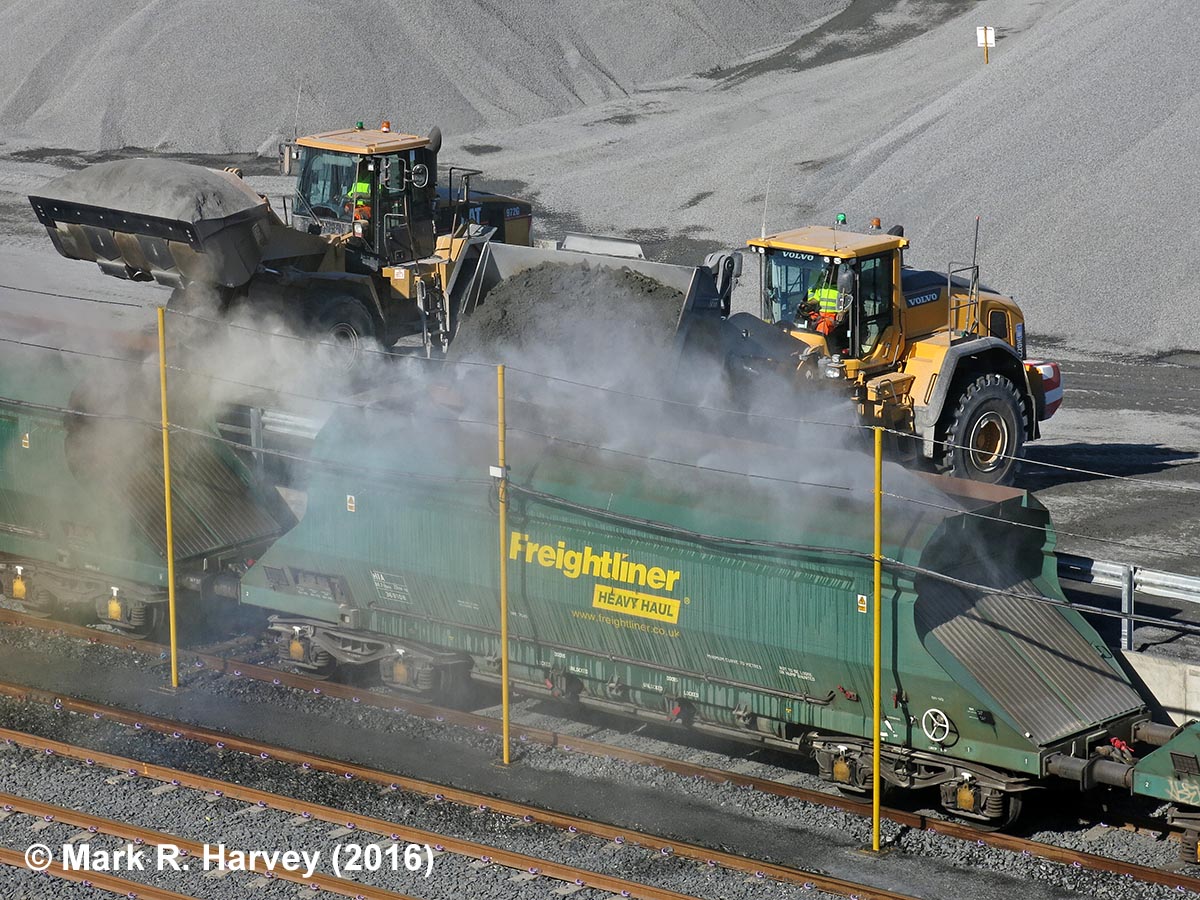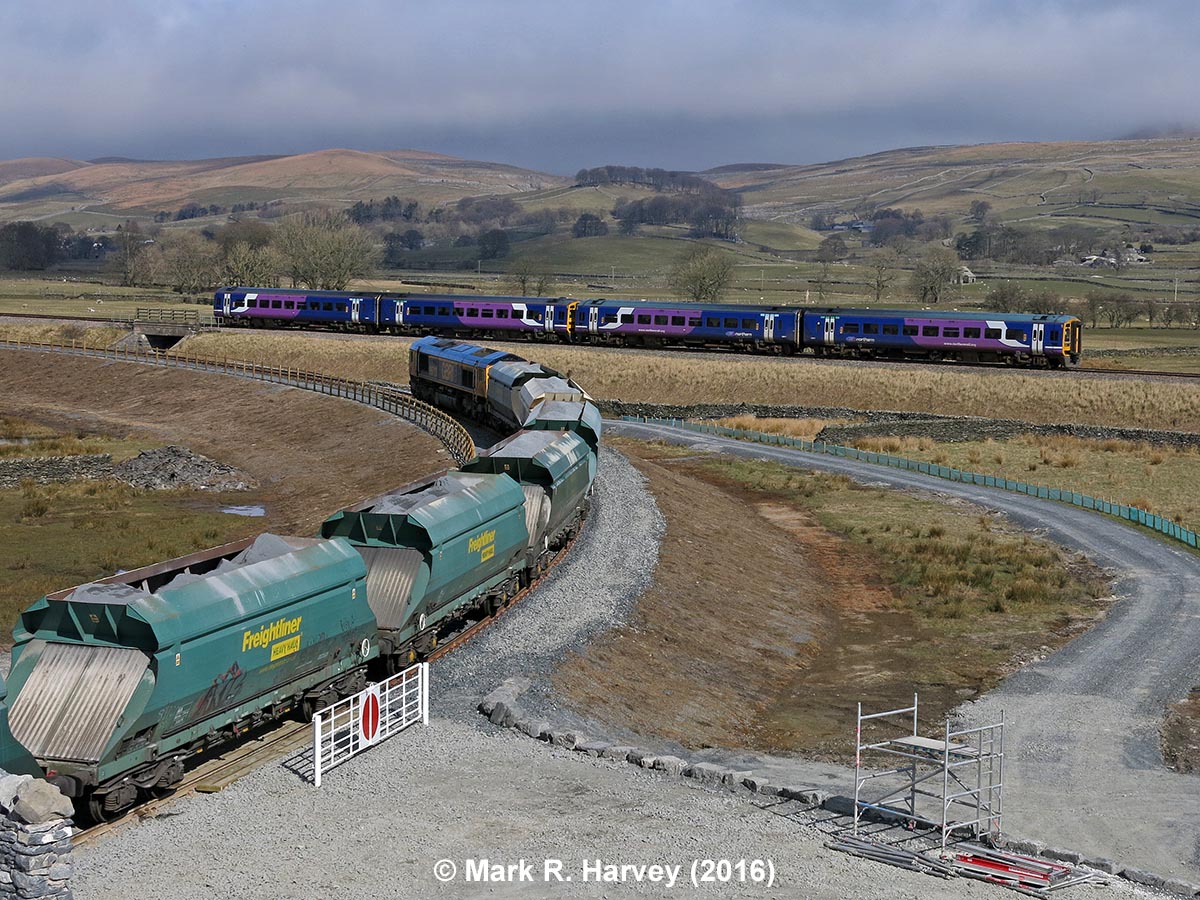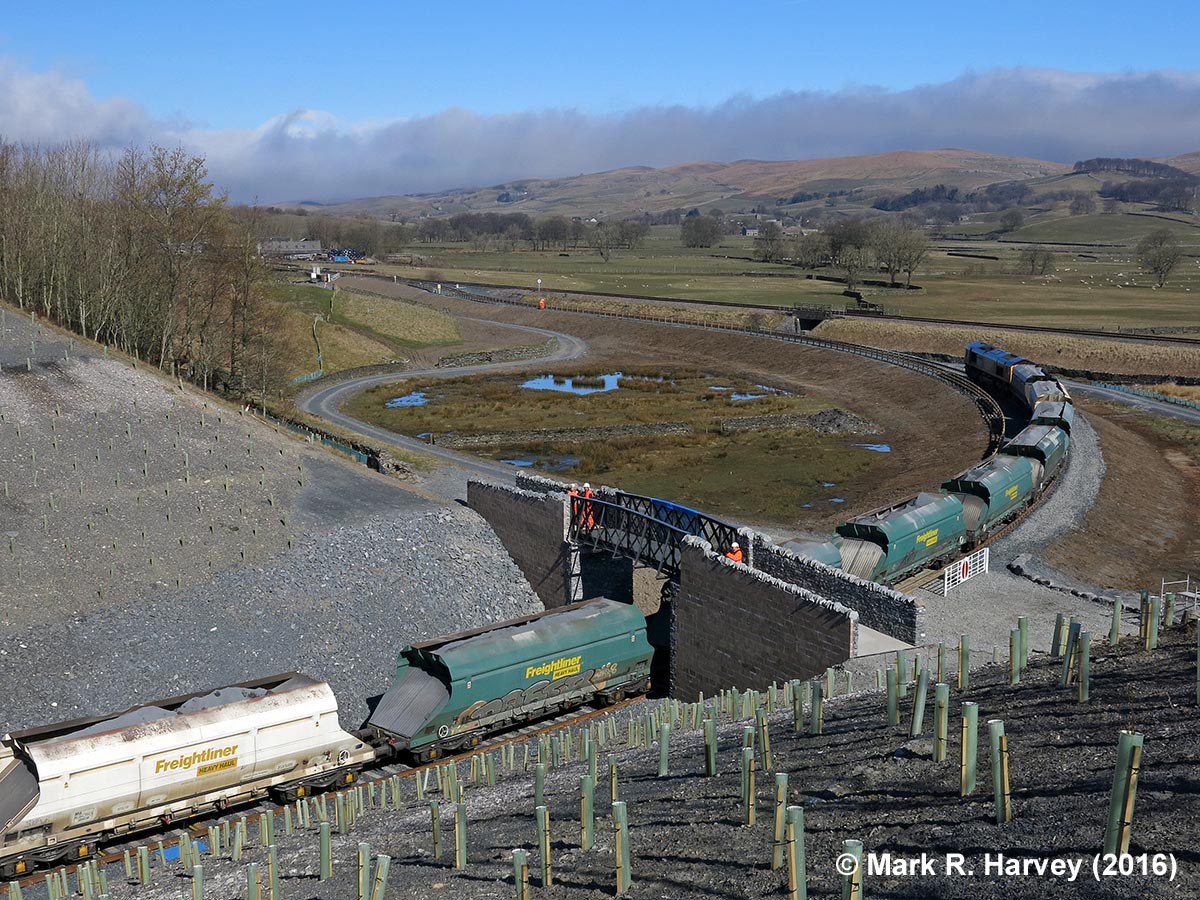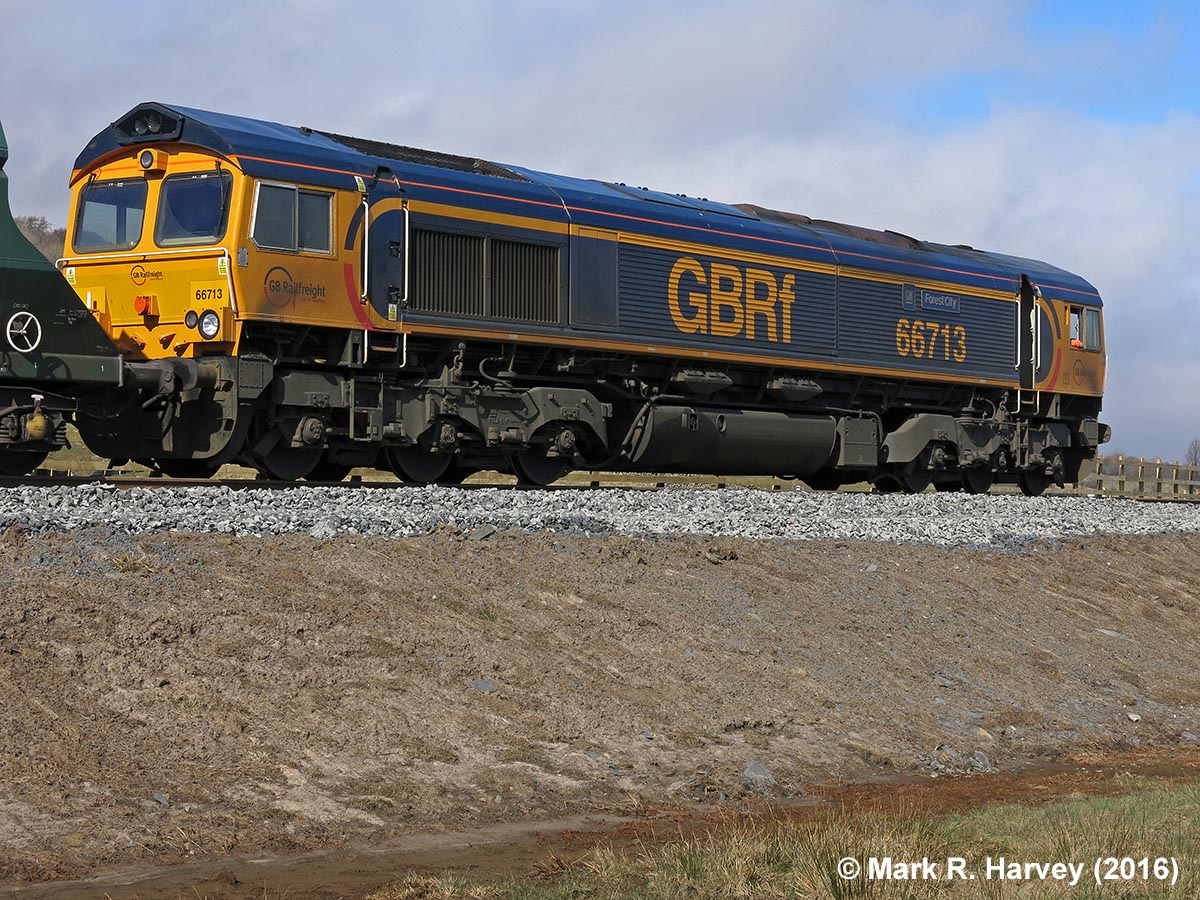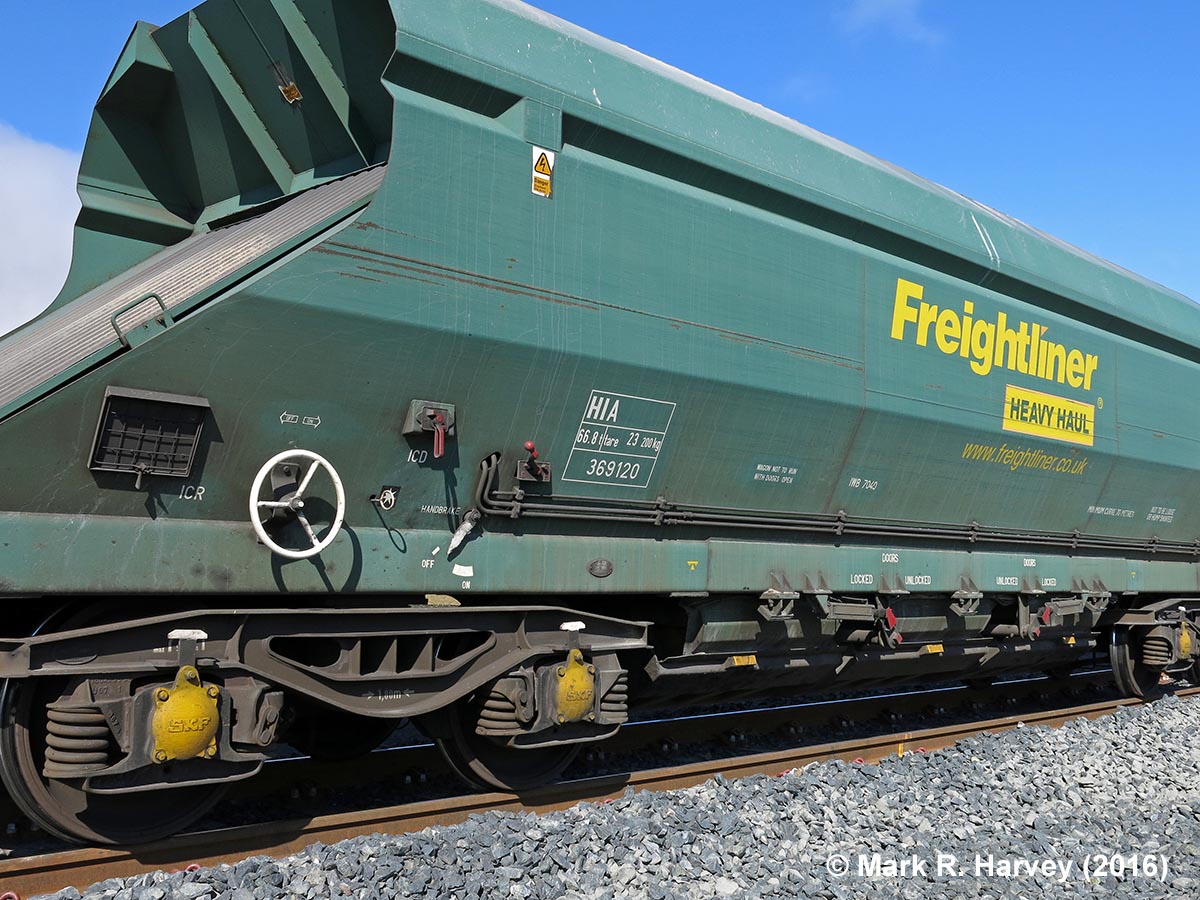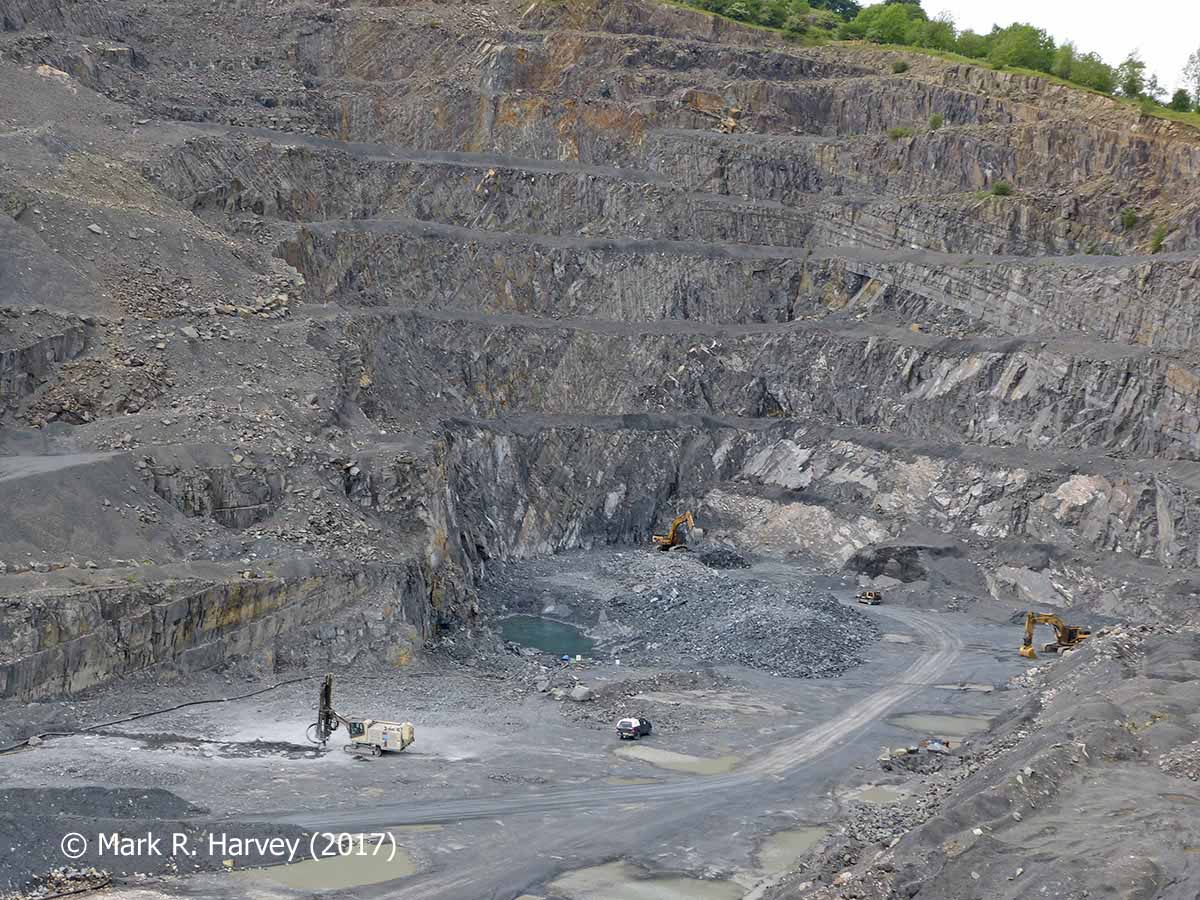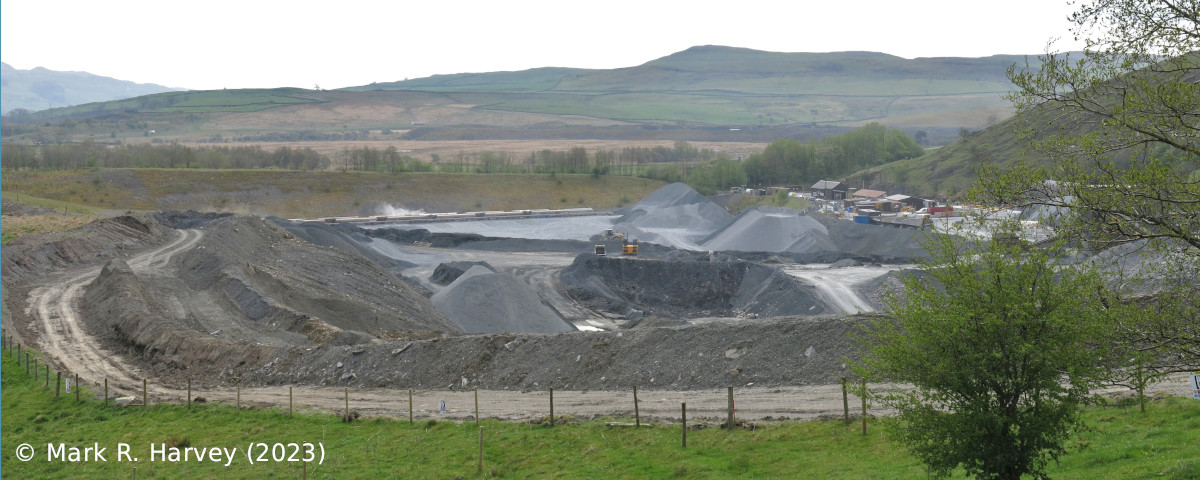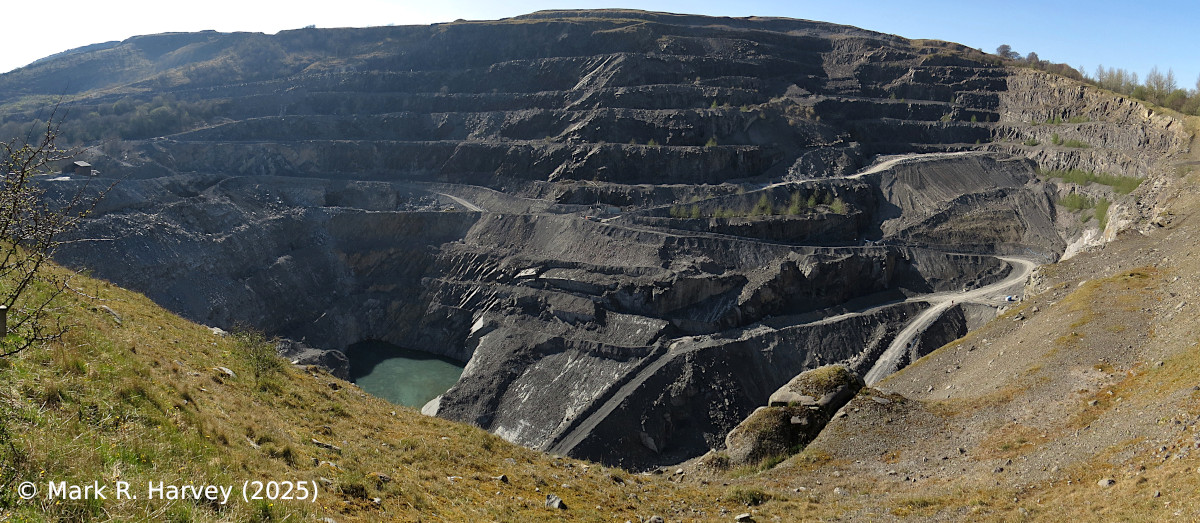After an absence of approximately fifty years, trains are once again able to serve Dry Rigg and Arcow Quarries at Helwith Bridge.
On Friday 18th March 2016 (shortly after the first test trains began rolling), a photography day was organised by Story Construction (the main contractor for the new siding construction project) and Lafarge-Tarmac (the company operating the quarries at that time) to officially record the completed infrastructure works. The information and most of the images below were obtained during this special event. Please note that the site is NOT accessible to the general public. However, parts of it can be seen from the low-level public footpath to the east (where it crosses the siding via the footbridge visible in Images 3 and 12) and from the new high level footpath to the northeast & north (as per Images 16 & 17).
Site overview
To allow trains to reach the quarry's despatch area from the Settle-Carlisle railway line:
- A monumental new cutting was created through the quarry's 'bund' (the bund is a visual screen formed decades ago by creating a large embankment from quarry spoil to screen the eastern boundary of the Arcow Quarry site).
- A new junction was inserted into the 'down' (northbound) main running line.
- A steeply graded and sharply radiused access spur (railway track) was laid from the new junction, through the new cutting and into the quarry site.
- Three sidings were created at the end of the spur.
- A raised loading area was constructed beside the northernmost siding.
- Dust suppression equipment was installed along full length of the loading siding.
- A new footbridge was constructed to carry the existing public footpath safely over the new spur.
The three images below provide an overview of these arrangements. They were taken from the top of the quarry bund, immediately to the south of the new cutting through it. The top of Dry Rigg Quarry is partially visible on the skyline at the extreme-left of Image 1. Arcow Quarry is partially visible just below the skyline in the centre of Image 2. The new junction with the mainline is visible in front of the locomotive towards the top-centre of Image 3. The new footbridge is clearly visible in Images 3 and 12.
What is the new rail-link for?
Two of the quarries at Helwith Bridge are now managed by a single organisation, a Lafarge-Tarmac joint venture. Roadstone is currently being extracted from Dry Rigg Quarry (see Image 4) and the company is seeking permission to extend the currently mothballed Arcow Quarry (see Image 5).
Both quarries were created to exploit the same geological formation: a highly-folded series of siltstones (see Image 6). These rocks are some of the oldest in Yorkshire, dating from the Silurian Period (they are approximately 420 million years old). The output from these quarries is ideal for surfacing high-speed roads and airport runways as it is highly skid-resistant. However, there are only six sources of this type of rock in England, hence the pressure to extend quarrying operations at Helwith Bridge. Unfortunately, the quarries lie within the boundary of the Yorkshire Dales National Park, so political, ecological and conservation issues need to be considered alongside commercial / economic factors. To this end, the Yorkshire Dales National Park Authority (YDNPA) included the following objective in its Management Plan for 2013-18:
D8: "Minimise road haulage and maximise the use of rail to transport quarry products and commercial timber, including establishing rail links at the three quarries in Ribblesdale and reducing combined road haulage from these quarries by at least 50% by 2015."
The New Rail-Link for Arcow and Dry Rigg Quarries is a direct response to this objective.
How is the new rail-link used?
The aggregate currently being transported by rail from the new sidings is quarried, crushed and graded at Dry Rigg Quarry, before being loaded into normal road tipper-lorries for the short journey to the new transhipment and loading area (see Image 7 below). Here, it is tipped-out, before being formed into neat piles by the bucket loaders. Each pile contains a different grade (size) of aggregate.
A train of empty Freightliner HIA-66T aggregate hopper wagons reverses down the spur and into the sidings. As the train is too long to fit into the loading-bay siding, it is split into shorter sections - hence the need for three sidings (see Images 8 & 9).
A pair of bucket-loaders then set to work transferring the aggregate from the temporary stockpiles into the hopper-wagons at the rate of six to eight tonnes per bucketful, depending on the size of the aggregate and the bucket-loader currently being used (see Image 10). To reduce the amount of airborne dust, a dust-suppression system has been fitted along the full length of the loading siding. Sensors fitted beneath the crash barrier at the edge of the loading platform detect the presence of an approaching bucket-loader, triggering a series of water-jets that create a fine mist along the full length of the wagon being loaded. The yellow poles supporting the water-pipes for the dust-suppression system can be seen in Image 9, as can the cloud of tiny water droplets that damp-down the dust caused by the loading process.
When all of the hopper-wagons have been loaded with up to 66 tonnes of aggregate, the paperwork is completed and the train then waits for the northbound passenger service - see Image 11.
As an example of the ecological constraints imposed during the construction works, the green plastic low-level fencing visible beside the access road (towards the right of Image 11) is newt fencing. This was installed prior to construction work commencing, when all of the Great Crested Newts in the area were carefully moved to a safer location by licensed handlers. The fence was installed to prevent the legally protected newts from returning before all construction work has ceased.
At the allotted departure time (subject to the timely passage of the passenger service), the train travels along the spur (see Image 12) and joins the 'down' (northbound) line for the eight-mile trip to Blea Moor Sidings.
Upon arrival at Blea Moor, the locomotive (see Image 13) runs-round the train, before heading back past Helwith Bridge (on the 'up' line this time) en-route to its destination. At the time of writing, the latter is either Beeston near Leeds or Manchester. Upon arrival there, the aggregate is emptied through the floor of the hopper wagons via central discharge chutes (the pneumatic mechanism for controlling these is visible in Image 14).
Update, 7th June 2017
The re-opening of Arcow Quarry is 'imminent' and preparatory works are underway to make the site ready for quarrying operations.
Compare Image 15 (right or below) taken on 7th June 2017 with the right hand side of Image 5 (above) which was taken on 18th March 2016.
Update, 4th May 2023
Just a couple of additional photos, as per the captions.
Update, 10th April 2025
An additional photo, as per the caption.
Further Reading
For background information relating to these quarries, see:
- SCRCA site 240951: Helwith Bridge Quarries
- SCRCA Knowledge Base for Helwith Bridge Quarries
- Geological Notes Relating to the Quarries at Helwith Bridge
Acknowledgements
Text and photographs by Mark R. Harvey (© Mark R. Harvey, 2016, 2017 & 2023).
The author would like to thank Mr. Chris Sidwell (the Arcow Project Manager for Story Construction) and the staff of Lafarge Tarmac for arranging the 2016 visit, for taking the time to show us around and for patiently answering endless questions.

